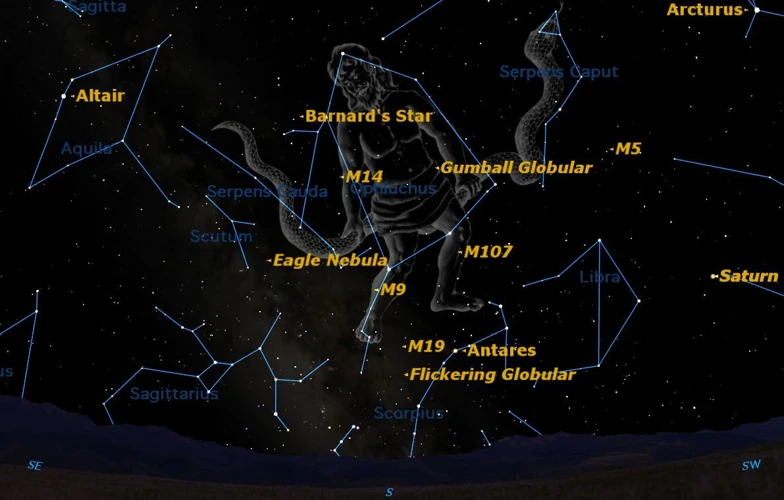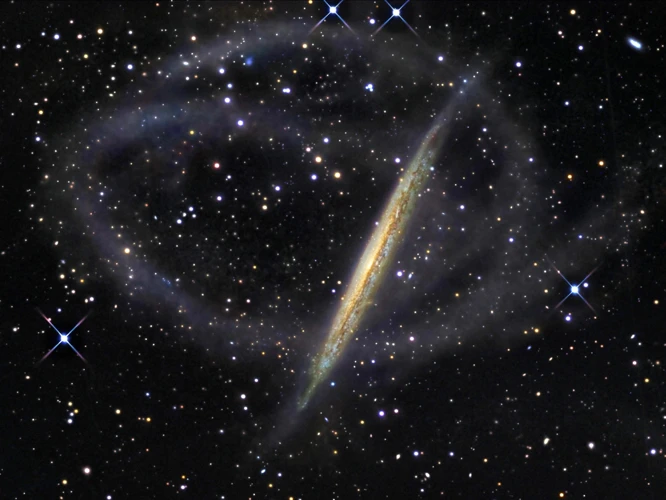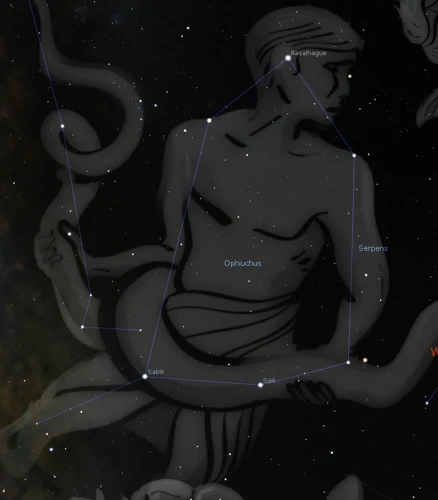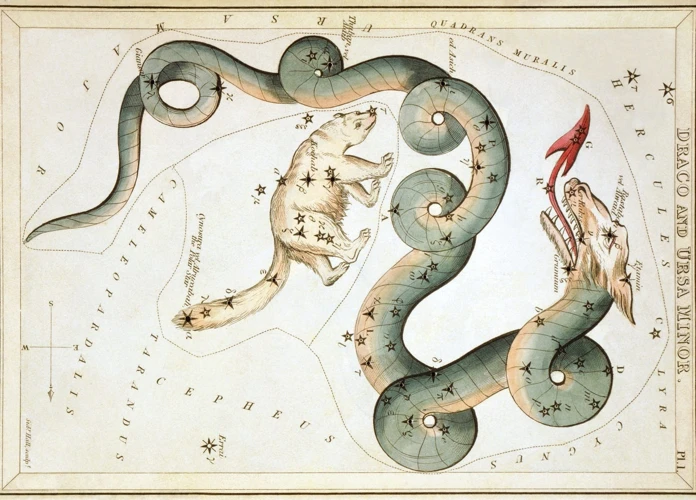Dragons have captivated human imagination since ancient times, appearing in myths, legends, and folklore from cultures all around the world. One such mythical creature is Draco, the dragon constellation that has fascinated both astronomers and storytellers. This celestial dragon, with its twisting body and pointed tail, has been a subject of wonder and interpretation across different cultures. In this article, we will delve into the origins of the Draco constellation in mythology, explore its significance in astronomy, and examine the various mythological interpretations of this legendary creature. Join us as we embark on a journey to unravel the mysteries and marvels of the magnificent Draco.
The Origins of Draco Constellation

The Origins of Draco Constellation are deeply rooted in ancient mythology and folklore. In both Ancient Greek and Roman mythologies, this celestial dragon holds a significant place. According to Greek mythology, Draco represents Ladon, a hundred-headed dragon tasked with guarding the golden apples in the garden of the Hesperides. This divine association demonstrates Draco’s connection to power, protection, and guardianship. In Roman mythology, Draco is linked to the dragon defeated by the goddess Minerva during the Gigantomachy, a battle between the gods and giants. The defeated dragon was then tossed into the heavens, where it transformed into the Draco constellation. These fascinating mythological origins have helped shape the enduring symbolism and allure of the Draco constellation throughout history. For related articles about the mysteries of the cosmos, you can explore the unraveling Pleiades mystery, the captivating mythology surrounding Orion’s Belt, or the exploration of mythological origins of Ursa Major and Ursa Minor constellations.
Ancient Greek Mythology
In Ancient Greek mythology, Draco is associated with the legendary creature Ladon. Ladon was a fearsome dragon with a hundred heads that guarded the golden apples in the garden of the Hesperides, which were known for their magical properties. This formidable creature was placed under the watchful eye of the goddess Hera. The hero Heracles, as part of his Twelve Labors, had to retrieve the golden apples. With his cunning and strength, Heracles successfully defeated Ladon and acquired the prized apples. As a tribute to this heroic feat, Ladon was placed among the stars, forever immortalized as the Draco constellation. This mythological tale showcases the significance of Draco as a symbol of power, protection, and the triumph of good over evil. To delve deeper into the captivating world of Greek mythology, you can explore the intriguing stories surrounding Orion’s Belt by visiting the article mythology of Orion’s Belt or the fascinating journey into the mythological origins of Ursa Major and Ursa Minor constellations in the article exploring mythological origins of Ursa Major and Ursa Minor.
Roman Mythology
In Roman Mythology, the Draco constellation has an intriguing origin story. According to the Roman legend, during the Gigantomachy, a colossal battle between the gods and giants, the goddess Minerva engaged in combat with a fearsome dragon. This mighty dragon, with its fiery breath and ferocious strength, posed a great threat to the gods. However, with her skill and strategy, Minerva managed to defeat the dragon, vanquishing it entirely. As a mark of her victory, Minerva hurled the lifeless body of the dragon into the heavens, where it transformed into the Draco constellation that we see today. This celestial dragon, forever frozen in the night sky, serves as a reminder of Minerva’s triumph and courage. The story of Draco in Roman mythology portrays the struggle between good and evil, highlighting the power of divine intervention and the triumph of righteousness over darkness.
Draco in Different Cultures

Draco, the dragon constellation, holds significance not only in Greek and Roman mythology but also in various other cultures around the world. In Chinese mythology, the dragon holds a revered position and is considered a symbol of power, prosperity, and good fortune. Known as Long in Chinese culture, dragons are associated with the Emperor, representing imperial strength and authority. In Indian mythology, the dragon takes the form of Vritra, a fearsome serpent-like creature that symbolizes chaos and obstructs the flow of rivers. However, in Norse mythology, the dragon assumes a different role. Fafnir, a dragon that guards a cursed treasure hoard, represents greed and the consequences of unchecked desire. The diversity in interpretations of dragons across different cultures showcases the universal fascination and awe surrounding these mythical creatures.
Chinese Mythology
In Chinese Mythology, the Draco constellation holds a significant place as well. Known as “TiānLóng,” the Celestial Dragon, it is regarded as a divine and auspicious creature. In the ancient Chinese zodiac, the dragon represents power, fortune, and good luck. The legend goes that the dragon’s celestial form was created by the god-emperor Fuxi, who brought order and balance to the world. In Chinese culture, the dragon is often associated with the concept of yin and yang, symbolizing harmony and the balance between opposing forces. The Draco constellation’s prominence in Chinese mythology is further emphasized by its inclusion in the Four Symbols, a grouping of celestial creatures representing the cardinal directions. The dragon is associated with the east and signifies spring, the season of renewal and new beginnings. This reverence for the Celestial Dragon in Chinese mythology highlights the cultural significance and deep-rooted belief in the mystical and auspicious nature of the Draco constellation.
Indian Mythology
Indian mythology also holds significant stories and beliefs regarding the Draco constellation. In Hindu mythology, the dragon-like creature represented by Draco is known as Naga. Naga is a powerful and revered deity associated with water, fertility, and protection. In Hindu cosmology, it is believed that Naga resides in the cosmic ocean and supports the four corners of the world. The serpent’s powerful presence in Indian mythology is evident in various ancient scriptures and folklore. According to one popular tale, the Naga Vasuki, a prominent serpent king, wraps himself around Mount Mandara to aid in the churning of the ocean during the Samudra Manthan, the great cosmic event. This event led to the discovery of invaluable treasures and the elixir of immortality. The significant role played by Naga in such mythological narratives showcases the reverence and cultural significance of the Draco constellation in the rich tapestry of Indian mythology.
Astronomical Significance of Draco

The Astronomical Significance of Draco lies not only in its mythical connections but also in its intriguing celestial properties. Draco is an elongated constellation located in the northern sky, crossing through the celestial North Pole. It is one of the largest constellations, spanning approximately 1083 square degrees. In terms of star formation, Draco hosts several notable stars, including the famous Thuban (Alpha Draconis), which was the North Star around 4,000 years ago. This historical significance makes Thuban a point of interest for astronomers and stargazers alike. Additionally, Draco contains other notable stars such as Eltanin (Gamma Draconis), Rastaban (Beta Draconis), and Etamin (Alpha Draconis), which form part of Draco’s distinct shape. The constellation is also visible in the sky during specific times of the year, making it a fascinating object of observation for those interested in astronomy. In fact, locating Draco is relatively easy, as it can be found between the Big Dipper and the Little Dipper. Its position and distinctive figure make it a great starting point for stargazing adventures. The astronomical significance of Draco, combined with its mythical history, adds to the allure and fascination surrounding this magnificent celestial dragon.
Star Formation and Location
The Draco constellation is known for its unique star formation and location in the night sky. It is situated in the northern celestial hemisphere and can be seen between the Big Dipper and the Little Dipper. Draco is a circumpolar constellation, meaning that it never sets below the horizon, making it visible year-round in the northern hemisphere. The constellation is dominated by several bright stars, including Thuban, the brightest star in Draco. Thuban, also known as Alpha Draconis, was once the North Star around 4,000 years ago during the time of the Ancient Egyptians. Other notable stars in Draco include Eltanin (Gamma Draconis), Grumium (Xi Draconis), and Edasich (Iota Draconis). These stars, along with numerous other smaller stars, form the distinctive shape of a dragon winding its way through the celestial sphere. The location and distinct star formation of Draco add to its allure and make it a captivating sight for stargazers and astronomers alike.
Draco in the Night Sky
Draco in the Night Sky is a mesmerizing sight for stargazers and astronomy enthusiasts. Located in the northern celestial hemisphere, the Draco constellation winds its way between the Ursa Minor and Ursa Major constellations. Its distinctive shape resembles a sinuous dragon, complete with a curving body and a pointed tail. The prominent stars that form Draco include Alpha Draconis (Thuban), Eta Draconis, and Beta Draconis (Rastaban). Thuban, in particular, holds historical significance as it was once the North Star around 4,500 years ago during the time the ancient Egyptians built the Great Pyramids. Today, however, Polaris has taken up the role of the North Star. To locate Draco, one can use the Big Dipper asterism by tracing an imaginary line from the end of the Big Dipper’s handle to the star Thuban. Observing Draco in the night sky can be a thrilling experience, as it allows us to connect with the mythical tales and ancient legends associated with this celestial serpent.
Mythological Interpretations of Draco

Mythological Interpretations of Draco have varied across different cultures and time periods. One prevalent interpretation of Draco is its association with the hero’s journey. In many mythologies, the dragon is often depicted as a formidable adversary that the hero must face and overcome in order to prove their bravery and worthiness. The constellation’s position in the night sky, coiling around the North Pole, has led to the belief that it acts as a guide or guardian for the hero’s quest. In this interpretation, Draco represents the challenges and obstacles that the hero must confront and conquer in their quest for glory or enlightenment.
Another common interpretation of Draco is its symbolism of power and wisdom. The dragon is often seen as a creature of immense strength and intelligence, possessing ancient and esoteric knowledge. This portrayal is particularly prominent in Chinese mythology, where dragons are revered as celestial beings associated with the emperor, representing imperial power and divine wisdom. In other cultures, Draco is seen as a guardian or protector, embodying the qualities of vigilance, watchfulness, and guidance.
To summarize, the mythological interpretations of Draco encompass themes of the hero’s journey, symbolizing challenges and guidance, as well as representations of power, wisdom, and protection.
The Hero’s Journey
One fascinating mythological interpretation of Draco is its association with “The Hero’s Journey.” In many cultures, dragons are seen as powerful adversaries that heroes must conquer to prove their worth, gain wisdom, and achieve victory. In this archetype, the hero embarks on a perilous quest, facing challenges and trials to ultimately slay the dragon and save the day. Draco, the mighty celestial dragon, embodies the ultimate test of bravery and heroism. Its presence in the night sky serves as a reminder of the hero’s journey, where individuals must confront their fears, overcome obstacles, and harness their inner strength to emerge triumphant. This mythical theme of the hero’s journey resonates deeply with human aspirations, inspiring us to face our own challenges, embark on personal quests, and strive for greatness.
Symbol of Power and Wisdom
Symbol of Power and Wisdom
The Draco constellation has long been associated with power and wisdom in mythological interpretations. In many ancient cultures, dragons were revered as majestic creatures embodying immense power. Draco’s position as a celestial dragon further amplifies its symbolism. The serpent-like body of Draco, winding through the night sky, represents the untamed forces of nature and the cosmic powers that govern the universe.
In Greek mythology, Draco’s association with Ladon, the fierce guardian of the golden apples, highlights its role as a powerful protector. The golden apples were seen as a symbol of divine knowledge and immortality, further emphasizing Draco’s connection to wisdom. The presence of Draco in the night sky served as a reminder of the strength and wisdom required to safeguard and preserve precious treasures.
The Roman interpretation of Draco’s defeat by the goddess Minerva symbolizes the triumph of intellect and strategic thinking over chaotic and destructive forces. This victory establishes Draco as a symbol of wisdom and rationality prevailing over primal instincts.
Across different cultures, Draco’s association with power and wisdom is evident. In Chinese mythology, the dragon is considered a symbol of imperial power and good fortune. The celestial dragon in the form of Draco is believed to bring prosperity and protection in Chinese astrology.
In popular culture, the image of the powerful and wise dragon has permeated literature, fantasy novels, movies, and television shows. Dragons often embody wisdom, serving as mentors or guides to heroes on their quests for knowledge and enlightenment.
The Draco constellation’s symbolism as a symbol of power and wisdom is deeply ingrained in mythology and resonates across various cultures and literature. Its representation as a guardian, protector, and bringer of wisdom highlights the cultural significance and enduring fascination with this celestial dragon.
Draco in Popular Culture
Draco, the dragon constellation, has left an indelible mark on popular culture, inspiring countless works of literature, fantasy novels, movies, and television shows. In literature, authors have often used dragons as central characters, portraying them both as fearsome beasts and wise creatures. Notable works such as J.R.R. Tolkien’s “The Hobbit” and George R.R. Martin’s “A Song of Ice and Fire” series feature dragons as integral and fascinating elements of the story. In the realm of movies and television, Draco’s influence can be felt in iconic franchises like “Game of Thrones” and “Harry Potter,” where dragons play pivotal roles in the narrative, captivating audiences with their awe-inspiring presence. These representations of dragons in popular culture showcase their symbolism of power, mystery, and sometimes even redemption. Draco’s enduring presence in popular culture speaks to the enduring fascination that humans have for dragons and their ability to ignite our imaginations.
Literature and Fantasy Novels
Literature and fantasy novels have embraced the allure and mystique of the Draco constellation, incorporating its essence into captivating stories and imaginative worlds. In various literary works, Draco is often depicted as a powerful and fearsome dragon, symbolizing strength, wisdom, and sometimes even malevolence. From the classic fantasy novel “Dragons of Autumn Twilight” by Margaret Weis and Tracy Hickman, where the constellation is referenced as a guiding force, to J.K. Rowling’s “Harry Potter” series, which features a character named Draco who exhibits both cunning and strength, these stories showcase the enduring fascination with Draco and its role in shaping mythical creatures in literature. Other authors, such as Christopher Paolini in his “Inheritance Cycle” and George R.R. Martin in “A Song of Ice and Fire,” draw inspiration from the Draco constellation to introduce legendary dragons and tales of heroic adventures. The symbolism and imagery associated with Draco continue to captivate readers, making it a beloved element in the realm of literature and fantasy novels.
Movies and Television Shows
Movies and television shows have embraced the intrigue and allure of Draco, featuring this majestic dragon constellation in various ways. In the realm of fantasy films, Draco often takes center stage as a powerful and wise creature. One notable example is the film “Dragonheart” (1996), where Draco is portrayed as a speaking dragon who forms a bond with a knight. The film explores the themes of redemption, friendship, and the battle between good and evil. Another popular film where Draco plays a prominent role is the “Harry Potter” series, with the character Draco Malfoy representing the constellation through his surname. In this context, Draco symbolizes cunning and manipulation. Television shows have also incorporated Draco’s symbolism, such as the popular series “Game of Thrones,” where dragons play a vital role in the story as powerful and awe-inspiring creatures. The portrayal of these mythical beings in movies and television shows ignites the imagination of audiences and reinforces the enduring fascination with Draco and its significance in mythology.
Conclusion
In conclusion, the legend of Draco, the dragon constellation in mythology, showcases the enduring fascination that humans have with mythical creatures and the stars above. Through ancient Greek and Roman mythologies, Draco’s origins are tied to stories of power, protection, and triumph over adversaries. Across different cultures, including Chinese and Indian mythologies, Draco takes on various interpretations, further highlighting its universal appeal. Astronomically, Draco occupies a significant position in the night sky, captivating stargazers with its prominent star formation and distinct shape. Moreover, Draco’s mythological significance is seen through its representation of the hero’s journey and its association with wisdom and power. The captivating allure of Draco has transcended time and found its place in popular culture, with appearances in literature, fantasy novels, movies, and television shows. From the ancient world to modern times, Draco continues to ignite imaginations and inspire awe in those who gaze upon the heavens. So, next time you find yourself gazing up at the night sky, don’t forget to search for the celestial dragon, Draco, and marvel at the rich mythological and astronomical heritage it holds.
Frequently Asked Questions
1. Why is Draco called the Dragon constellation?
Draco is called the Dragon constellation because its serpentine shape resembles that of a dragon. In various mythologies, dragons are often associated with power, wisdom, and mythical creatures capable of great feats.
2. How can I spot the Draco constellation in the night sky?
To spot the Draco constellation, look for its distinctive shape resembling a snake or dragon. It is best observed during the northern hemisphere’s late spring or early summer, appearing between the Big Dipper and the Little Dipper.
3. What are the major stars in the Draco constellation?
The most prominent stars in the Draco constellation include Alpha Draconis (Thuban), which was once the North Star around 4,000 years ago, and Eltanin (Gamma Draconis), one of the brightest stars in the constellation.
4. What is the significance of Draco in Chinese mythology?
In Chinese mythology, Draco is associated with the dragon king of the four seas, Longwang. Longwang is a powerful and benevolent figure who controls the weather and ensures the well-being of all aquatic creatures.
5. Is Draco mentioned in Indian mythology?
Yes, in Indian mythology, Draco is known as “Naga,” a celestial serpent associated with the Nagas, divine beings half-human and half-serpent. Nagas are considered powerful protectors and guardians of treasure.
6. How does the Draco constellation relate to the Hero’s Journey?
In the Hero’s Journey, the Draco constellation symbolizes the trials and tribulations that the hero must face during their quest. It represents the challenges they must overcome to attain wisdom, power, and ultimately, triumph.
7. What does Draco represent as a symbol of power and wisdom?
Draco represents power and wisdom due to its association with dragons in various mythologies. Dragons are often depicted as wise and ancient creatures, possessing immense power and knowledge.
8. Are there any literary works that involve the Draco constellation?
Yes, the Draco constellation has appeared in various literary works, particularly in fantasy novels. One notable example is J.K. Rowling’s Harry Potter series, where Draco Malfoy’s name is derived from the constellation.
9. Have there been any movies or TV shows featuring Draco?
While the Draco constellation might not be explicitly featured in movies or TV shows, dragons inspired by Draco have made appearances. For example, the dragons in the “Game of Thrones” series share similarities with the dragon archetype associated with Draco.
10. What is the overall significance of the Draco constellation?
The overall significance of the Draco constellation lies in its enduring presence in various mythologies and its representation of power, wisdom, and the hero’s journey. It continues to captivate our imagination and serves as a reminder of the rich tapestry of human storytelling.








